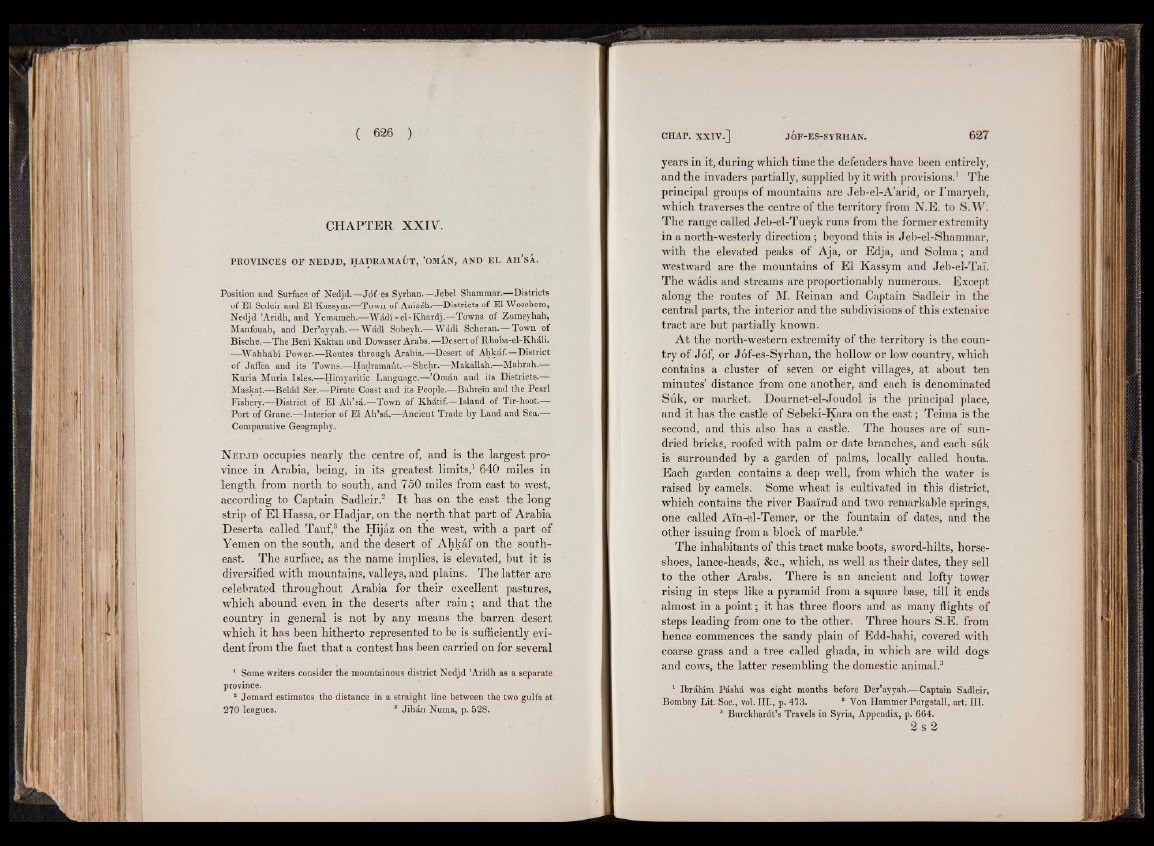
CHAPTER XXIV.
PROVINCES OF NEDJD, HADRAMAtJT, ’OMAN, AND EL Ah’SA.
Position and Surface of Nedjd.—Jó f es Syrhan.—Jebel Shammar.—Districts
of El Sedeir and El Kassym.—Town of Anizeh.—Districts of El Woschem,
Nedjd ’Aridh, and Yemameh.-—Wád i-el-Khardj.—-Towns of Zumeyhah,
Manfouah, and Der’ayyah. -—Wádl Sobeyh.— Wádi Scheran.— Town of
Bische.—The Beni Kaktan and Dowaser Arabs.—Desert of Rhoba-el-Kháli.
—Wahhabi Power.—Routes through Arabia.—Desert of Ahkáf.—District
of Jaffea and its Towns.—Hadramaiit.—Shehr.—Makallah.-—Mahrah.—-
Kuria Muria Isles.—Himyaritic Language.—’Omán and its Districts.-S
Maskat.—Belád Ser.—Pirate Coast and its People.—Bahrein and the Pearl
Fishery.—District of El Ah’sá.—Town of Khátif.—Island of Tir-hoot.—
Port of Grane.—Interior of El Ah’sá.—Ancient Trade by Laud and Sea.—■
Comparative Geography.
N e d jd occupies nearly the centre of, and is the largest province
in Arabia, being, in its greatest limits,1 640 miles in
length from north to south, and 750 miles from east to west,
according to Captain Sadleir.2 It has on the east the long
strip of El Hassa, or Hadjar, on the north that part of Arabia
Deserta called Tauf,3 the Hijáz on the west, with a part of
Yemen on the south, and the desert of Ahkáf on the southeast.
The surface; as the name implies, is elevated, but it is
diversified with mountains, valleys, and plains. The latter are
celebrated throughout Arabia for their excellent pastures,
which abound even in the deserts after rain; and that the
country in general is not by any means the barren desert
which it has been hitherto represented to be is sufficiently evident
from the fact that a contest has been carried on for several
1 Some writers consider the mountainous district Nedjd ’Aridh as a separate
province.
8 Jomard estimates the distance in a straight line between the two gulfs at
210 leagues. 8 Jihán Numa, p. 528.
years in it, during which time the defenders have been entirely,
and the invaders partially, supplied by it with provisions.1 The
principal groups of mountains are Jeb-el-A’arid, or I’maryeh,
which traverses the centre of the territory from N.E. to S.W.
The range called Jeb-el-Tueyk runs from the former extremity
in a north-westerly direction; beyond this is Jeb-el-Shammar,
with the elevated peaks of Aja, or Edja, and Solma; and
westward are the mountains of El Kassym and Jeb-el-Ta'i.
The wadis and streams are proportionably numerous. Except
along the routes of M. Reinan and Captain Sadleir in the
central parts, the interior and the subdivisions of this extensive
tract are but partially known.
At the north-western extremity of the territory is the country
of Jof, or Jof-es-Syrhan, the hollow or low country, which
contains a cluster of seven or eight villages, at about ten
minutes’ distance , from one another, and each is denominated
Suk, or market. Dournet-el-Joudol is the principal place,
and it has the castle of Sebeki-Kara on the east; Teima is the
second, and this also has a castle. The houses are of sun-
dried bricks, roofed with palm or date branches, and each suk
is surrounded by a garden of palms, locally called houta.
Each garden contains a deep well, from which the water is
raised by camels. Some wheat is cultivated in this district,
which contains the river Baai'rad and two remarkable springs,
one called Ain-el-Temer, or the fountain of dates, and the
other issuing from a block of marble.2
The inhabitants of this tract make boots, sword-hilts, horseshoes,
lance-heads, &c., which, as well as their dates, they sell
to the other Arabs. There is an ancient and lofty tower
rising in steps like a pyramid from a square base, till it ends
almost in a point; it has three floors and as many flights of
steps leading from one to the other. Three hours S.E. from
hence commences the sandy plain of Edd-hahi, covered with
coarse grass and a tree called ghada, in which are wild dogs
and cows, the latter resembling the domestic animal.3
1 Ibrdhlm Pdshd. was eight months before Der’ayyah.—Captain Sadleir,
Bombay Lit. Soc., vol. III., p. 473. 8 Von Hammer Purgstall, art. III.
3 Burckhardt’s Travels in Syria, Appendix, p. 664.
2 s 2